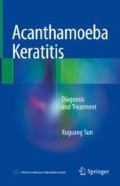Abstract
Please check the hierarchy of the section headings and confirm if correct.
Access this chapter
Tax calculation will be finalised at checkout
Purchases are for personal use only
References
Niederkorn JY, Alizadeh H, Leher H, et al. The pathogenesis of Acanthamoeba keratitis. Microbes Infect. 1999;1(6):437–43.
Niederkorn JY, Ubelaker JE, McCulley JP, et al. Susceptibility of corneas from various animal species to in vitro binding and invasion by Acanthamoeba castellanii [corrected]. Invest Ophthalmol Vis Sci. 1992;33(1):104–12.
Panjwani N, Zhao Z, Baum J, et al. Acanthamoebae bind to rabbit corneal epithelium in vitro. Invest Ophthalmol Vis Sci. 1997;38(9):1858–64.
Yang Z, Cao Z, Panjwani N. Pathogenesis of Acanthamoeba keratitis: carbohydrate-mediated host-parasite interactions. Infect Immun. 1997;65(2):439–45.
Kay EP, He YG. Post-transcriptional and transcriptional control of collagen gene expression in normal and modulated rabbit corneal endothelial cells. Invest Ophthalmol Vis Sci. 1991;32(6):1821–7.
Larkin DF, Easty DL. External eye flora as a nutrient source for Acanthamoeba. Graefes Arch Clin Exp Ophthalmol. 1990;228(5):458–60.
Mitra MM, Alizadeh H, Gerard RD, et al. Characterization of a plasminogen activator produced by Acanthamoeba castellanii. Mol Biochem Parasitol. 1995;73(1-2):157–64.
Khan NA, Jarroll EL, Panjwani N, et al. Proteases as markers for differentiation of pathogenic and nonpathogenic species of Acanthamoeba. J Clin Microbiol. 2000;38(8):2858–61.
McClellan K, Howard K, Niederkorn JY, et al. Effect of steroids on Acanthamoeba cysts and trophozoites. Invest Ophthalmol Vis Sci. 2001;42(12):2885–93.
Park DH, Palay DA, Daya SM, et al. The role of topical corticosteroids in the management of Acanthamoeba keratitis. Cornea. 1997;16(3):277–83.
John T, Lin J, Sahm D, et al. Effects of corticosteroids in experimental Acanthamoeba keratitis. Rev Infect Dis. 1991;13(Suppl 5):S440–2.
Pettit DA, Williamson J, Cabral GA, et al. In vitro destruction of nerve cell cultures by Acanthamoeba spp.:a transmission and scanning electron microscopy study. J Parasitol. 1996;82(5):769–77.
Larkin DF, Berry M, Easty DL. In vitro corneal pathogenicity of Acanthamoeba. Eye (Lond.). 1991;5(Pt 5):560–8.
Alizadeh H, Pidherney MS, McCulley JP, et al. Apoptosis as a mechanism of cytolysis of tumor cells by a pathogenic free-living amoeba. Infect Immun. 1994;62(4):1298–303.
An Q, Zhang X, Mei B, et al. Cytotoxic effect of Acanthamoeba trophozoite on hela cells. Chin J Parasitol Parasit Dis. 2001;19(1):37–40.
An Q, Zheng Y, Zhang P, et al. Cytotoxic effect of Acanthamoeba trophozoites on human melanoma cells. Acta Parasitol Med Entomol Sin. 2002;9(1):7–11.
Chen W, Sun X, Liang Q, et al. The clinical and histopathologic changes of experimental Acanthamoeba keratitis in rabbit. Chin Ophthalmic Res. 2009;27(1):27–31.
Stewart GL, Kim I, Shupe K, et al. Chemotactic response of macrophages to Acanthamoeba castellanii antigen and antibody-dependent macrophage-mediated killing of the parasite. J Parasitol. 1992;78(5):849–55.
van Klink F, Leher H, Jager MJ, et al. Systemic immune response to Acanthamoeba keratitis in the Chinese hamster. Ocul Immunol Inflamm. 1997;5(4):235–44.
van Klink F, Alizadeh H, He Y, et al. The role of contact lenses, trauma, and Langerhans cells in a Chinese hamster model of Acanthamoeba keratitis. Invest Ophthalmol Vis Sci. 1993;34(6):1937–44.
Cursons RT, Brown TJ, Keys EA, et al. Immunity to pathogenic free-living amoebae: role of humoral antibody. Infect Immun. 1980;29(2):401–7.
Walochnik J, Obwaller A, Haller-Schober EM, et al. Anti-Acanthamoeba IgG, IgM, and IgA immunoreactivities in correlation to strain pathogenicity. Parasitol Res. 2001;87(8):651–6.
Mattana A, Cappai V, Alberti L, et al. ADP and other metabolites released from Acanthamoeba castellanii lead to human monocytic cell death through apoptosis and stimulate the secretion of proinflammatory cytokines. Infect Immun. 2002;70(8):4424–32.
Bingji S, He X, Zhu L, et al. The clinical value of annular infiltration in the diagnosis and treatment of Acanthamoeba keratitis. American Medical Association. J Ophthalmol. 2000;12:40–2.
McClellan K, Howard K, Mayhew E, et al. Adaptive immune responses to Acanthamoeba cysts. Exp Eye Res. 2002;75(3):285–93.
Yang YF, Matheson M, Dart JK, et al. Persistence of Acanthamoeba antigen following Acanthamoeba keratitis. Br J Ophthalmol. 2001;85(3):277–80.
Leher HF, Alizadeh H, Taylor WM, et al. Role of mucosal IgA in the resistance to Acanthamoeba keratitis. Invest Ophthalmol Vis Sci. 1998;39(13):2666–73.
Alizadeh H, He Y, McCulley JP, et al. Successful immunization against Acanthamoeba keratitis in a pig model. Cornea. 1995;14(2):180–6.
Niederkorn JY. The role of the innate and adaptive immune responses in Acanthamoeba keratitis. Arch Immunol Ther Exp. 2002;50(1):53–9.
Author information
Authors and Affiliations
Rights and permissions
Copyright information
© 2018 Springer Nature Singapore Pte Ltd. & People's Medical Publishing House, PR of China
About this chapter
Cite this chapter
Sun, X. (2018). Pathological Mechanisms and Immunological Reactions. In: Acanthamoeba Keratitis. Springer, Singapore. https://doi.org/10.1007/978-981-10-5212-5_3
Download citation
DOI: https://doi.org/10.1007/978-981-10-5212-5_3
Published:
Publisher Name: Springer, Singapore
Print ISBN: 978-981-10-5211-8
Online ISBN: 978-981-10-5212-5
eBook Packages: MedicineMedicine (R0)

